Managing stormwater pollution

Managing stormwater is a continuous challenge for Auckland City and several strategies are already in place to address stormwater contamination. Pollution in some estuaries is causing concern, and recent studies by NIWA for Auckland City Council have found that metal loads (zinc and copper) are relatively high in some urban catchments. The good news, however, is that management options can significantly improve the situation.
Modelling the pollution
Using NIWA’s stormwater quality model, we produced a one year time series estimating contaminant loads at five-minute intervals for selected catchments within the city’s 38 drainage management areas.
The model is designed to take account of catchment characteristics, such as slope, sediment or contaminant accumulation rate, catchment area, wash-off coefficient, and land use. It can be adjusted to reflect the rate at which a contaminant is washed off at low and high stormwater runoff intensities.
One important finding was the significant contribution that industrial catchments make to the total zinc loads. In these industrial areas, the zinc load is almost entirely attributable to roof runoff – mainly from unpainted or poorly maintained galvanised iron roofs. These industrial areas are next to estuaries of concern.
What does the future hold?
If no additional action is taken to reduce stormwater contaminant loads, we estimate zinc loads could increase by about 11% by 2050. However, if the source of zinc was controlled, we expect zinc contamination levels up to 60% lower than with no control or further treatment.
What can be done?
Much is already being done. Our results reinforce the benefits of moving from treating the stormwater to controlling the source of contaminants, especially zinc. Amongst the management options:
- Estimated annual total zinc loads could be cut roughly in half if galvanised iron roofs were replaced or painted with non-zinc paints. The single most effective action, and one of the simplest, would be to address contamination from the roofs of large, single storey buildings typical of industrial areas.
- Total suspended sediment could be reduced by about one-fifth by continuing to use catchpits or similar technology on roads.< /li>
A heavy load
Zinc & copper: high concentrations can be toxic to aquatic organisms
Suspended sediment: can smother aquatic organisms and alter habitat
